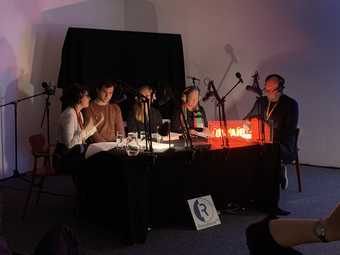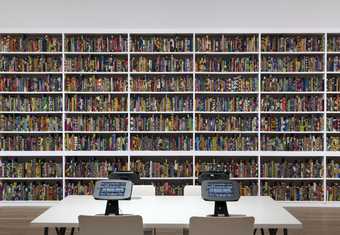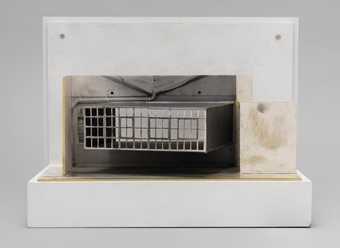Introduction
The aim of this report is to introduce the practice of archives and records management through a brief overview of their historical and theoretical evolution, before focusing on how current debates translate to the context of a contemporary art museum via current practice at Tate, and then exploring possible avenues for my research as part of the project Reshaping the Collectible: When Artworks Live in the Museum. The project looks at how the museum can support artworks that challenge its own structures: works which unfold during their life in the museum, or are liable to change over time, perhaps by their dependence on external networks or changes in technology; and works that could be considered ‘boundary objects’, blurring the boundaries between artwork, archival material, record and didactic display.1
My role within the project is twofold – beyond undertaking my own research which will be the focus of this report, I will also actively work with the team and wider record creators at Tate such as curators, conservators and researchers to understand what it means to work with a changing collection, and how to capture such practice effectively in their records. I will be embedded in the Library and Archive department, and my engagement with the archive and public record collections will shape my research and perspective. The public record collection will provide an insight into Tate’s institutional practices and how the institution captures the life of an artwork as it enters the collection and interacts with different departments over its lifetime in the museum. Cataloguing collections in the Tate archive will extend my own research interests and experience in how to archive artistic practice effectively.
My research follows two strands that relate to two key research questions. Firstly, when artworks are acquired that blur the established boundaries between artwork, record and archive, how is the status of this material determined? And secondly, leading on from the initial research, what kinds of records do we need to capture in order to demonstrate how these ‘unruly’ and boundary-blurring artworks unfold in the museum?2
Mapping the field
Published in 1922, Hilary Jenkinson’s A Manual of Archive Administration established a practical and concise set of rules for the archivist.3 For Jenkinson, the creator of the document sets its order and value by assigning it to the archive, while the archivist is the guardian. Authority is passed through the documents which become evidence of truth and fact.4 Jenkinson’s focus on an authenticity that could only be achieved by an unbroken chain of custody and provenance saw subsequent bodies of theory remain focused only on the record creator.
Jenkinson did not account for the inconsistencies in records, record creators and researchers. As these factors evolved, so did the role of the archivist, and with it the status of the archive. Archival theory did not begin to emerge as its own area of academic study until the 1980s. The introduction of theory was not met with enthusiasm by all archivists, with detractors like John W. Roberts believing that there was no place for theoretical or philosophical posturing within a profession rooted in practice.5 In his 1999 essay ‘The Place of Theory in Archival Practice’, the archivist Preben Mortensen gives a potential reason for the increased interest in archival theory during this period:
Theoretical reflections about a discipline or an established practice typically arise when the practice or the discipline has reached a point in its development when it can no longer be continued exclusively on the basis of the already established or traditional practices. The legitimacy of a particular practice may be questioned by someone outside that practice, or people engaged in the practice may encounter problems for which there are no longer straightforward practical solutions. Ethical concerns may raise a conflict with what is ‘expected’ of the archivist. Conflicts or problems (anomalies) for which the traditional practice does not provide guidelines may arise. They call for reflection, perhaps for a renewal of practice. Theoretical reflections therefore grow out of the development of practice.6
Archival practice has also been questioned by outside disciplines. The archive has undertaken an ontological shift from repository to metaphor,7 and has come to represent memory, power and truth, opening itself up to deeper investigation. Postmodern archival practice has come to understand that archives are not neutral places, and that they do not hold neutral records. Making records is not a neutral act, and neither is using them. Consciously or unconsciously, a record creator is evidencing an agenda; records are created for a purpose. If the archive has come to serve as society’s collective memory, then the archivist has been imbued with a power and status but also the responsibility to acknowledge that not all facets of society are included in the official record; that there are gaps and inconsistencies in what has been saved for posterity; that what is not included is as telling as what is; that there is more than one historical narrative. Archivist Sue McKemmish writes that by moving away from an unquestioned truth and neutrality in the record (and the role of the archivist), the discipline is given the power to explore ‘processes of remembering and forgetting, inclusion and exclusion, and the power relationships they embody, depicting archives as political sites of contested memory and knowledge’.8
The postmodern archival paradigm also acknowledges that these issues are not exclusive to the archive, but also to the record creators. As the prominence of the archive has continued to grow, other disciplines have turned to it to solve some of their own dilemmas around identity, memory and power. The protective boundaries of the archive that previously supported one dimensional practice as established by Jenkinson have dissolved and the archive has looked outwards to define its new role as a subjective and proactive practice. Parallel to this transformative phase of professional practice, artists also began to look to the archive to explore their own practices, thus blurring the boundaries between archive and artwork.
Museum archives are set apart from other institutional archives in both principle and practice; they are more likely to hold challenging, non-traditional material such as artefacts,9 and singular, de-contextualised items that have no other place in the museum,10 as well as oral histories. This is applicable at Tate, where material has moved through both the main collection and the archive as collecting and artistic practices have evolved, and as the parameters of value have changed.11 It is this moment of practice that I will address with my first research question: when artworks are acquired that blur the established boundaries between artwork, record and archive, how is the status of this material determined? By addressing this question, this part of the project will contribute to the field by documenting the principles that underpin decisions regarding the boundaries of records, archives and artworks within the contemporary art museum.
At Tate, there are two separate archival collections – Public Records and Tate Archive – and each is managed by a separate team. Public Records is Tate’s historic institutional records collection, which documents the history of Tate and its practices and outputs. Tate Archive collects material relating to the history of British art; this is not limited to British artists, but those who have lived and worked in Britain and contributed to the canon of British art history.
Like other national museums Tate is listed as a ‘Public Record Body’. As such, it is obliged to manage its records in line with the Public Records Act 1958 and also to comply with legislation including the Freedom of Information Act 2000 and the Data Protection Act 2018. It is also designated a ‘place of deposit’ under the Public Records Act (1958). The Act states that Tate, on behalf of the nation, must preserve and make available its institutional records in all formats, to provide an audit trail demonstrating the museum’s accountability and transparency in all its business functions. This material is what constitutes Tate’s public records, and is overseen by the Records Manager.
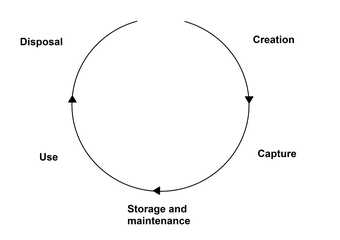
Fig.1
Diagram of the ‘Life Cycle’ model, published in Elizabeth Shepherd and Geoffrey Yeo, Managing Records: A Handbook of Principles and Practice, London 2003, p.6
Tate follows the ‘Life Cycle’ model of managing records (fig.1). Introduced in 1956 by T.R. Schellenberg’s Modern Archives: Principles and Techniques, the five stages of a record’s life cycle are identified as: creation, capture, storage and maintenance, use, and disposal. Schellenberg’s framework evolved from a need to manage the large quantities of government records created during and after the Second World War.12 It sought to establish what, how and by whom records were being created. The ‘Life Cycle’ model therefore highlights the different purposes a record serves during its active existence, and who is responsible for its management at each stage before it is appraised for permanent retention in the archive or for destruction. Records management is a practice-led discipline; its evolution has been tied to legislative change and this model has been widely adopted and taught.
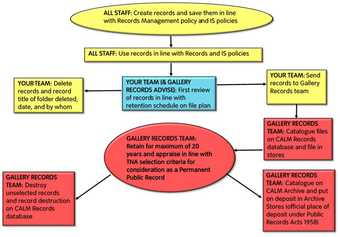
Fig.2
Tate’s ‘Life Cycle’ model (‘Records Management at Tate’ induction presentation)
At Tate, as in most organisations, the responsibility lies with the record creators to manage and undertake an initial review of their information in line with retention schedules. Following the life cycle model, each department is responsible for the creation and management of records in the active part of their life ensuring they are captured into a file plan (fig.2). Departments transfer their semi-current records to the central Library and Archive Stores, where they are kept for up to twenty years in line with government legislation. Prior to the end of this period, they are appraised to determine if they meet the criteria for permanent retention. If considered to have ongoing business, legal or historical value, they are then permanently retained in the institutional archive on deposit as historical public records. Those records that are not considered to meet the criteria are destroyed.
A museum is built on its collection documentation and at Tate, these types of records include, but are not limited to: acquisition (provenance, contracts, negotiations with the artist, estate, studio, gallery, or present owner of the artwork, and board notes as produced by curators); conservation (historic research, pre- and post-acquisition costings to bring the work into the collection, interviews with artists, condition and treatment reports, and records created in the process of exhibiting, displaying and loaning an artwork); registration (loans, collection management and display specifications); art handling; and exhibitions and displays. As Tate’s conservation records are continually used and added to, they are considered permanent ‘current records’ and remain with the record creators. However, they are subject to the same legislation as records which have been transferred and are therefore made available if requested by researchers.
There are several introductory and instructional texts about how to manage records, both digital and paper, in a business context. While wide in scope, they are limited in detail.13 Records Management for Museums and Galleries: An Introduction by Charlotte Brunskill and Sarah R. Demb is the only text dedicated to records management in the museum or art gallery.14 For larger museums like Tate, where records management practice is so dependent on legislation, this type of text dates quickly and any professional moving into a role in a larger museum should inherit a records management structure that meets legislative requirements. However, these texts may best serve smaller museums and galleries where there is no records management structure in place, nor staff with formal training, but an abundance of material. The lack of relevant literature could be a symptom of the combination of limited public funding and legislative obligation, which leaves (usually) small teams underfunded and overworked. The necessary focus on practice leaves little time for theoretical engagement.
Reshaping the Collectible is the first research project at Tate to have a researcher situated within the Library and Archive team, allowing records management to take an active role in aiding the understanding of how Tate collects unruly artworks.15 Tate’s ability to make these invisible moments visible to audiences is dependent on the collection documentation, and therefore its institutional record-keeping practices. One method of testing Tate’s institutional records and their ability to capture its collecting practices is to look at a record’s ‘thickness’.16 In this context ‘thickness’ refers to an artwork’s unruliness, the implication being that the thicker the record, the more complicated and interesting a life the artwork has had in the museum.17 However, I would argue that thickness does not always have to mean complex; repeated exhibition and loans would generate multiple records, meaning that thickness could also represent an artwork’s value to the museum and popularity with audiences.
Beyond the thickness of the record, Kreplak illustrates that institutional records not only tell the history of an artwork and the museum but provide an opportunity to find other narratives. Acquisition records tell ‘the historicity of conservation and curatorial practices of particular artworks through time’.18 Kreplak’s paper demonstrates that beyond providing evidence of accountability, institutional records also contain narratives that capture what it means to work with artworks in collections like Tate’s and how these records are evidence of ‘ongoing achievements of institutional practices’.19 One potential research question that evolves from this thinking asks how Tate’s records management practices might move beyond a culture of compliance, simply capturing records for evidentiary and accountability purposes. To extend this further, we must consider the question of whether these records are effectively capturing developments and shifts in practices, values and approaches, as well as Tate’s place in histories of art collection and exhibition. Throughout the research project, as the embedded archive and records management researcher, I will gather all the relevant institutional records available for each case study. Each researcher can then test the effectiveness of the records in their research. Identifying potential gaps in the record is an opportunity to open a dialogue around the types of records we are creating as an institution and the stories we want to tell about the collection and Tate’s practices. This will be particularly important with any case study where there may be few relevant records (for example, an acquisition candidate) and we will have to determine which newly created records support the acquisition and which support the research.
As an artwork has the potential to interact with several departments during its lifetime in the contemporary art museum, the management of collection documentation must take precedence as it dictates so much of the workflow. In his paper ‘From Catalogues to Contextual Networks: Reconfiguring Collection Documentation in Museums’, archivist and historian Michael Jones writes that
the future of museum documentation (including museum archives) is in relational, interconnected information structures … these systems must be developed in a way which allows for rich, complex linking between things (including conceptual entities), whether or not the professional standards employed explicitly represent such relationships.20
Applying this sort of thinking to future records management in the context of collection documentation would allow its capture to be viewed as a process ‘where things are identified as … explicitly related rather than relying on the implicit knowledge of staff to navigate through collections’.21 Jones adds that relying on implicit, internal knowledge means that ‘users relying on collection documentation will need to repeat prior work; at worst, there is a risk of significant organisational loss’.22 Reshaping the Collectible is therefore also an opportunity to reconsider Tate’s record management practices, and potentially even embrace other methodologies.
The ‘Records Continuum’ model is one such alternative methodology. The profession’s preoccupation with solving the preservation challenges posed by electronic records means the continuum has been the only significant development in records management theory since Schellenberg. The continuum rejects the ‘Life Cycle’ model’s distinction between record and archive. In the continuum model, a record’s value is not measured in time or content but in the context of creation and the potential value for different audiences.23 Its creator, Frank Upward, proposes that ‘the biggest challenge of our era [is] the instant construction of archives that can be electronically communicated across vast spaces and through long reaches of time’.24 Upward’s colleague at Monash University, Barbara Reed, redefined a record as follows: ‘A good record is accompanied by waves of context and connections. A record is never a single object; it is always an object with connections. A record cannot be separated from the events that precipitated it nor the person who created it or was involved in it.’25
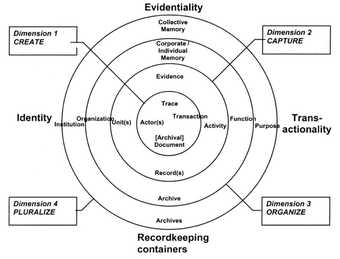
Fig.3
Diagram of the ‘Records Continuum’ model, published in Frank Upward, ‘The Records Continuum’, in Sue McKemmish, Frank Upward, Barbara Reed and Michael Piggott (eds.), Archives: Recordkeeping in Society, Wagga Wagga 2005, p.203
The ‘Records Continuum’ theory is the integration of records management and archival practices to ensure the preservation of context and a record’s authenticity. Unlike the life cycle, which establishes clear boundaries between a record’s activity, use and management, the continuum sees no distinguishing factor between a record’s value at creation and its historic value in the archive. It aligns with the postmodern shift in archival practice and the archivist’s transition into a more proactive, engaged role, but also the need to act quickly to preserve digital information. The continuum’s focus is simultaneously on use and preservation. Looking at the diagram (fig.3) the four dimensions are: Dimension 1, CREATE – how and why a record is created; Dimension 2, CAPTURE – when the record is captured into an institutional framework that links it to other records; Dimension 3, ORGANIZE – how the record is organised or contextualised so that anyone wishing to use it will understand its purpose; and Dimension 4, PLURALIZE – how the record is used (pluralised) and how its use creates new information. You see the different purposes that records serve within each dimension, a feature which aims to preserve context and maintain accountability and evidentiary value as it moves through the dimensions. Each axis (evidentiality, identity, transactionality and recordkeeping containers) represents a recordkeeping process that preserves the context and value of the record.
In the continuum, the value of a record is continuous – at creation the records have the same potential value for supporting current business purposes as they will at an archival phase in the life cycle. Keeping records active in the system in which they were created (especially digital records) – and engaging archival principles alongside records management ones – places an emphasis on capturing provenance and context, key for new staff and potential external users. This is also true for when records take on a more passive role in the continuum (where in the life cycle they would become archival records) and is why there is an ‘archives’ coordinate in the ‘PLURALIZE’ dimension on the ‘recordkeeping containers’ axis.
In practice, this is similar to how Tate manages its conservation records. The records are repeatedly returned to during an artwork’s lifetime as they are evidence of previous practice. In doing so they shape institutional memory and support the creation of new records throughout the artwork’s life in the contemporary art museum. This material does not fit within the life cycle model because it never reaches the end of its life cycle; the records remain ‘current’ as long as Tate owns the artwork, yet the records are subject to the same legislation and are made available for archival research if requested. The record is as valuable at creation as it would be in the archive for capturing and evidencing moments of institutional practice.
Methodology
Within the project, the key research questions I will examine are as follows:
- When artworks are acquired that blur the established boundaries between artwork, record and archive, how is the status of this material determined?
- What kinds of records do we need to preserve in order to capture the life of a complex artwork within the museum?
With the archival and records management theory outlined above as my basis, I arrived at these questions through my initial research into the longlist of artworks nominated to be subject of a case study.26 This research included conversations with curators, researchers and other Tate staff about their engagement with the archive and records management. It also included archival research into the acquisition records for the nominated artworks. This offered ample opportunity to understand the records management practices at Tate across the curatorial, conservation and research departments, and I have developed several overarching modes of investigation that will feed into this research. I am primarily concerned with how records are created, and how information is disseminated through Tate.
These research questions also stem from my own interest, as an archivist, in other disciplinary readings of ‘the archive’ and what, in a post-postmodern paradigm, the archive sector can take from these interventions to continue evolving its own practice. This is particularly focused on the artist’s changing relationship with their own documentation practices, and the archive as a site of creative process. Finally, the intention of these research questions is to highlight the areas in museum practice, outlined theoretically above, where records management needs to and can be more intuitive and flexible. On evaluation of the project, these investigations will seek to inform the design and delivery of future research projects. However, they also have the potential to shape the creation of Tate’s institutional records.
The first question arose during the initial research, when it became evident that several of the nominated artworks stipulate that the acquisition include ‘an archive’ of supporting material – material collected at each activation, sometimes for each edition; material that would, following a basic definition of the archive, be considered archival. Sometimes this material is considered by the artist to be part of the artwork and in other cases it is not, but the institutional records show that artists are determining the boundaries between collection and archive. There is no articulated policy around these interventions and what follows is a series of examples where this material has found itself in different places within the institution, as directed by the artist.
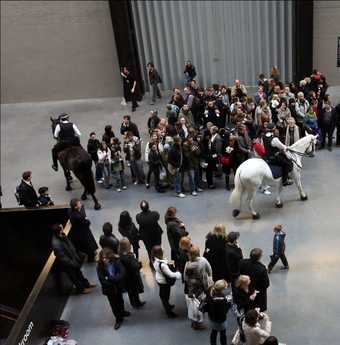
Fig.4
Tania Bruguera
Tatlin’s Whisper #5 2008
Tate T12989
© Tania Bruguera
Tatlin’s Whisper #5 2008 by Tania Bruguera (fig.4) is a performance work in which two mounted policemen control the movement of visitors within the exhibition space. The acquisition of the performance included documentation from its previous presentations, and states that the owner is responsible for collecting an archive of the work. A copy of the archive must also be sent to the artist.27 The artist stipulates that the documentation can never be shown in place of the performance, and the public can only see the documentation in the context of an exhibition about documentation and archives. The artwork would also have to be performed as part of this exhibition.28 In one capacity this could be considered a generative archive, about which there is no professional literature because it is at odds with archival principles – when a creator transfers more material to an archive, this would generate a new archival record to respect the context of creation. The records would be linked in the cataloguing process, which brings the material together intellectually. The archive material generated for Tatlin’s Whisper #5 could be reframed and approached as a living archive,29 but in the current framework at Tate, as this archive material is considered part of the artwork, these ideas have to be discussed with the artist. In this example, all of the material has remained in the main collection as part of the artwork, managed by the Time-based Media Conservation team, but its existence is not known outside of the studio or the museum.
Pawel Althamer’s Film 2000 (Tate T12404) was acquired as a performance, film and archive material. Film is a ninety-second trailer for a thirty-minute performance and is made and shown in cinemas in anticipation of the performance. A new trailer is made each time the performance is reactivated, using an iconic venue and actor for the location in which it is shown. The performance enacts the events depicted in the trailer. For example, when performed in conjunction with the exhibition The World as a Stage at Tate Modern (24 October 2007 – 1 January 2008), the performance included Jude Law buying a fish in Borough Market, as he had done in the trailer. Upon acquiring the work, Tate also acquired the complete archive of the work and previous presentations, including documentation, drawings by the artist, storyboards and photographs.30
Film is different at each activation, and the archival material is for internal and ‘archival use’ only; this implies for research or reference, but it is unclear. In an interview with the artist and several of Tate’s staff, Althamer explained that this material is not part of the work itself, and would therefore be able to exist in the archive.31 They discussed placing it in Tate’s archive, but no definitive answer was given by the artist. The material remains in the main collection with the artwork. No one from the archive department was invited to be present during this conversation.
Film and Tatlin’s Whisper #5 are both performance artworks, and were acquired as such. Prior to Tate’s acquisition of its first performance work in 2005,32 artists had sold – and Tate had collected – performance documentation (videos, photographs or a combination as installations). These research questions seek to understand if the ability to collect performances changes the status of their documentation, and to understand how important the process of documentation is to artists if they are not separating it from the artwork at acquisition. One interpretation could be that they are legitimising the work through its documentation. A performance is an ephemeral work, it does not exist outside of the performance itself, and therefore has no physical presence in Tate’s collection. What is it about ‘the archive’ that both Bruguera and Althamer are trying to explore in their practice? Is this a question our research can attempt to answer?
The next two examples are both installation artworks, which raises other questions around why they have included an archive. How does an archive support the acquisition of these types of artworks, and how are artists making the distinctions between artwork and archive that appear more blurred in performance works? Both artworks were created as part of collectives, which raises the question: is it more effective to produce an archive for each collectively produced artwork rather than have the material dispersed across the archives of a number of artists? What effect does splitting archive collections like this have on researchers?
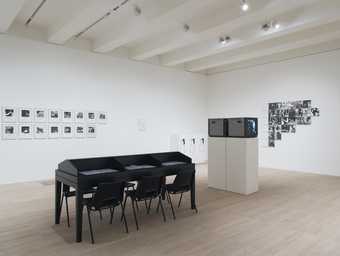
Fig.5
Margaret Harrison, Kay Hunt and Mary Kelly
Women and Work: A Document on the Division of Labour in Industry 1973–75 1973–5
Tate T07797
© Margaret Harrison, Mary Kelly and the Estate of Kay Fido
Margaret Harrison, Kay Hunt and Mary Kelly’s Women and Work: A Document on the Division of Labour in Industry 1973–75 1973–5 (fig.5) consisted of so much material that upon acquisition the artists wished to re-evaluate how the work should be displayed going forward. The artists were invited to Tate to work through the material with the curators and conservation department in order to determine each element of the artwork. In an interview between Tate conservation staff and Margaret Harrison, she expressed an interest in having any remaining material collected for archival purposes.33 The artists in this example reassessed what constitutes the artwork and what constitutes the archive. The museum actively invited the artists to determine these boundaries. Unlike in the case of Althamer’s Film, the archival material is part of the archive collection.
T.R. Uthco and Ant Farm’s The Eternal Frame 1975–6, refabricated 2008 (Tate T13850), was acquired by Tate in 2012. The conservation documents include several references to an archive by Doug Hall (of T.R. Uthco), including an inventory of archive material compiled by him and Chip Lord (of Ant Farm) in 2010. There is another direct reference to this archival material in some correspondence between film curator Stuart Cromer and the artists.34 This artwork was nominated as a case study for Reshaping the Collectible by Tate’s archivist, Adrian Glew. During our conversations about this work it transpired that this archive material had initially remained with the work in the main collection; the archive department were not involved in the acquisition and the material was not transferred to the archive until a later date.35
Each of these archives could be considered boundary objects, as defined by Leigh Star and James Griesemer.36 While these archives can exist uncontroversially alongside the artwork in the main collection as this is the context of their creation, they are in their nature archival and would exist equally uncontroversially in the archive. As a researcher I am interested in investigating if artists are deliberately using this material to cause tension between these established museum boundaries. What can the archival sector learn from artists who appropriate archival methodologies (Bruguera: living archives;37 Harrison, Hunt and Kelly: micro-appraisal)38 into their artistic practice? How does this impact the collecting practices of the museum archive, and archival practice as a whole? Selecting any of these works as a case study would allow further research into the practices around acquiring archive material via the main collection.
There is an opportunity to open a dialogue around the tensions these materials potentially cause to the boundaries between the archive and the main collection. This would better articulate institutional ideas of value between the collections, how the boundaries between the collections are articulated through Tate, and how artists themselves understand, value and determine these distinctions. One methodology for doing so will be to identify key stakeholders and develop a set of principles, definitions and a decision-making workflow that can be incorporated into the acquisition process. This process could take its lead from Atul Gawande’s 2009 book The Checklist Manifesto: How to Get Things Right.39 Gawande, a surgeon and health researcher, uses the checklist as a pre-planning and organisational tool to manage complex professional practices. He gives a series of historical examples that prove that the simplicity of the checklist means that it can be applied to any infrastructure as the boundaries are determined by practice. Tate’s commitment to its collection utilises several different bodies of knowledge; an acquisition checklist would do the same for each acquisition candidate. It would capture this knowledge, in one place, for each artwork, while fitting into an established workflow framework. This information could prove invaluable as the artwork continues to unfold over its lifetime in the museum. This tool could potentially be tested on future case studies, or future acquisitions that include archive material, for example Richard Bell’s Embassy 2013–ongoing.40
The second research question I will be addressing explores the nature of the records we create, and how they capture an artwork’s relationship to the institution. In a contemporary art museum, where staff move through the institution in a multitude of roles over long periods of time but also leave the organisation (sometimes after relatively short periods of time), capturing implicit, internal knowledge will always be one of the biggest challenges. Legislation such as the Freedom of Information Act has been understood to affect the capture of certain information,41 but does this play a role in the prevalence of implicit knowledge within institutions? While intuitive records management structures make the transfer of knowledge more beneficial to ongoing practice and institutional research, records management can only manage the records that exist; capturing implicit knowledge is ultimately the responsibility of the knowledge holder. It would be impossible to retrospectively fill gaps as they may not be recognised until it is too late, and for those undertaking institutional research, this knowledge needs to be captured into a system that demonstrates the complex and interrelated nature of institutional knowledge.
As ninety-five per cent of Tate’s records are born digital, the vast majority of collection documentation, except for emails (unless explicitly captured by staff), is stored in Tate’s shared drive, together with and linked to the collection database, The Museum System (TMS). The shared drive is organised by function rather than department as organisational structures frequently change. In the current system there is no way to link the information by content, and there is no effective search functionality. There are other resources to find information, including the archive and semi-current and historical public records catalogues, annual reports, the collection management system (if the member of staff has access) and the Tate website where every artwork in the main collection is listed. However, piecing together this information to create a coherent narrative would likely leave gaps that only this implicit, internal knowledge could fill. But how does an institution recognise internal knowledge? How does it set the parameters of what knowledge is valuable in the moment that it is created, and not in hindsight when a particular moment or practice becomes the subject of research? Those who work directly with artworks to bring them into the museum are aware of the importance of collection documentation and its role in being able to carry out their work.
Over its lifetime in the contemporary art museum an artwork will generate records across a variety of departments. Each record is considered an institutional record and will follow one of three paths in the museum: it will retain its status as a current record (as with the conservation records); it will be appraised for permanent retention and transferred to the institutional archive; on review it will either be placed on deposit as a historical public record for the nation or destroyed as it has no continued business value, or does not meet the criteria for a historical public record. Retrospectively, the life of an artwork may have to be pieced together through the archive, public records, conversations with colleagues, the collection database and the shared drive, but it can be traced through the institutional records. This is because, returning to Kreplak, the documentation of artworks is ‘a constitutive feature of their institutional existence’.42
Initial research shows that Tate captures the life of an artwork in the museum well, and Kreplak’s idea of ‘thickness’ cannot singularly be used as a measure of an artwork's complexity or value to a collection. To capture the life of an artwork as it unfolds in the museum, we must first understand what records work well in registering these moments of change and re-engagement. Once we have established these parameters, we can identify what is missing in the records, and try to understand why it has been missed. In establishing this, we must then tackle how to present these narratives to audiences in line with our legislative obligations as a Public Record Body. Promoting a better understanding of the life of an artwork in the museum is a justification for the public funding received as a national museum and the funding of ongoing collection research, as well as encouraging continued engagement. It creates a better understanding of these works of art, how entering the museum changes them (if it changes them at all), and, in the context of this research project, how the museum changes in turn to include them in the collection.
Conclusion
The aim of this report has been to highlight areas within Tate’s record management and archival practices that respond to the project proposal. I have taken the list of nominated artworks and drawn out issues that can be researched further by measuring established practice and testing new methodologies. Language is important in contemporary archival practice, and I have found both at Tate and in artistic practice that the terms ‘archive’, ‘documentation’, ‘record’ and ‘preparatory/secondary material’ are used interchangeably. The artworks in the collection that evoke this language and test the boundaries between artwork, archive and record (including those not nominated for a case study) have come into the collections over a number of years, during a period that has seen performance art become collectible as the performance itself rather than in documentary format. This creates questions around the status of the documentation, as in the Bruguera and Althamer works. A lack of articulated practice is therefore understandable because of the breadth of what is being discussed, but I want to explore whether Tate might be able to shape a definition of the archive that can be articulated to artists and reflected in collecting practices going forward.
In establishing the two main research questions, I acknowledge that I do not have the internal and implicit knowledge that other staff have to navigate internal systems, politics, inherent knowledge and a sense of institutional history. Therefore, it is key to note that as my research continues it is likely that these research questions will change, but as they do so, that this report can serve as a benchmark for continued evaluation. The interdisciplinary interest in the archive sits between archival ‘function’ (such as collecting, ordering, classification and description) and what the archive represents metaphorically (memory, identity, truth, legacy, power, authenticity and authority). I am not proposing or making suggestions for change in an institution where I only have nine months of experience, but highlighting areas of tension that, in line with the project proposal and my professional experience, I believe would merit further research because there is potential to add value to Tate’s institutional practices and wider theoretical thinking.

